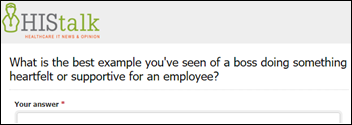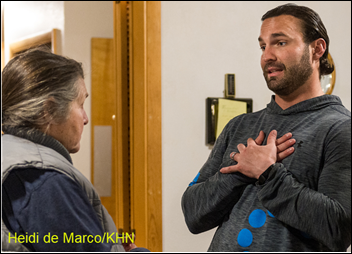Lillian Dittrick, MAAA is VP of actuarial and healthcare analytics at Health Alliance Plan of Detroit, MI and is a fellow of the Society of Actuaries.

Tell me about yourself and your job.
Henry Ford Health System owns a health insurance company called HAP, Health Alliance Plan. I am building for them both their actuarial and analytics function. I am an actuary and an FSA in the Society of Actuaries. I have extensive actuarial and analytics experience for both the payer and the provider. This is a good and exciting fit for me since it’s both of them combined. I feel strongly that payers and providers need to collaborate for both to succeed. We have the same end goals. Whether we’re calling them members or patients, we’re supporting the same people.
Prior to this, I was at Highmark, leading their provider analytics area, and before that, I spent a number of years embedded in a large provider system.
When I hear “actuary,” I think of a life insurance company person who can tell from an Excel worksheet when I’ll die. What is the training of actuaries and how is their analytics approach different?
[laughs] Your comment is more what a life actuary would do. A life actuary is more mortality versus a health actuary, which is morbidity. There are a number of tracks you can go down for an actuary. It could be in more the investment realm, too, and a lot of actuaries are in that space.
Predictive analytics is a lot of the education, which is newer to healthcare, but not newer to many industries. You have to go through a series of exams that have a heavy reliance on math, actuarial science, and modeling in general. It’s really in that modeling space.
Over the last few years, the Society of Actuaries has added specific education that speaks to predictive modeling. They’re revamping their education and recognizing and understanding the importance of predictive modeling. Actuaries, with that heavy math and modeling education and background, are well suited to do that kind of work in any industry.
Beyond EHR and claims data, what data sources are important for creating a healthcare model?
Both of those are important. It’s important for payers and providers to share that information so they have as complete a picture on a patient as possible.
Also important are social determinants of health. There’s a lot that goes on with a patient that can be used to predict their future healthcare use that you will not find just looking at their claims history. Information about whether they have someone to help them, if they need help getting medications, or if they have transportation issues. People present in the ED or hospital because they didn’t have a way to get to their follow-up appointments. Or, they have a financial barrier to obtaining medications that would keep them out of the ED and hospital. Payers and providers alike, more strongly in the provider realm right now, are recognizing that and are performing assessments to capture that information.
A number of government grants are going on now to help providers work with the community to link people up with all of the resources that may be available, such as social services, that can help fill in those gaps to make sure that people are getting the appropriate care they need, when they need, and where they need it.
Reports suggest that insurers are buying consumer data to, depending on who you believe, either cherry-pick less expensive patients or to create tailored health interventions. What are people doing with less-obvious data sources and what are the ethical issues involved?
That is very much a concern. When SOA did the survey, challenges around HIPAA and regulatory issues came up pretty high as a barrier to implementing predictive analytics. All insurers that I have worked for, because you were speaking more to the insurance side, are very aware of those ethical issues. I haven’t seen them using any data inappropriately. They’re all using that data to try to understand the best care to wrap around a patient. I’m aware of least two places, here and Highmark, that have programs with Lyft to help people get the transportation they need to their appointments. Unless you are able to collect that information, you’re not able to provide that extra level of care that the patient needs to make sure they’re receiving that care where they need it and when they need it.
What are the analytical challenges of trying to draw insights from a population that’s heterogeneous to begin with, but that is also changing all the time?
Not having complete data and those regulatory issues or having the technology and skill to deploy those kinds of models. I don’t think employers always realize that when they have actuaries on the staff, those are the skills they need and the people who are suited to doing that kind of work. They are under-utilizing the skillset in the actuaries they have.
Incomplete data is always on the top of the list. What I have found in my experience is you can do a lot with what you have. You do not need to wait for perfect information. There will always be holes and some gaps in your data. Tools, technology, and methodology can help you fill in some of those gaps. But even with having some gaps in data, you can draw a lot of good conclusions by just going forward with the information that you have.
How could a mid-sized health system create a predictive analytics service and what low-hanging fruit might provide the fastest benefit?
Leverage models that are already created first. There’s a lot of them out there that are good. It’s not like you’d have to re-create the wheel and do all of that coding yourself. There’s models that are available out there that you can utilize that use both claims and EHR data. You can alter them based on what you have.
The larger EHR vendors have embedded predictive analytics in their model that can be leveraged. If you are a smaller organization trying to figure out where to start, especially on the provider side, you can generally utilize models that you have within the vendor that you’re already using.
The low-hanging fruit that I’ve found involve inappropriate ED utilization, inpatient readmissions, and admissions for something that could have been prevented around chronic conditions. I’ve seen models in all of those areas embedded in EHRs. That’s the easiest place for people to start.
University of Minnesota is offering to license an algorithm they developed to predict one-year patient mortality based on EHR data. Is it as simple as just creating a good algorithm and seeing results?
If someone has created an algorithm, you can take it in house and make it fit for your data. It could be that with your population and demographics, you’ll get different results, and maybe you need a variation of that model. I’m not saying it’s a “one size fits all” model, but if a health system or payer has found success with the theme of a model – something around readmissions or blood utilization — then it’s likely that someone else will, too.
Do actuaries get involved on the front lines with convincing clinicians to trust their information and to change their habits?
Yes, absolutely. The success I’ve found is from beginning to end, where we have had the physician and clinical involvement. Both from designing new algorithms and new processes all the way through to having physician champions that are out there helping us. Sometimes they are the ones taking that message out and sharing it with other physicians. I absolutely believe that.
Whoever your audience is, but certainly with the providers, you can’t just dump a whole bunch of data and Excel spreadsheets on people. You need to present it in a way that’s visual, actionable, and tells a story, so that anyone can pick that information up and know the two or three things to work on right now for success in that model solution is that’s being developed. You’re not going to pull it across the finish line unless you have the physician champions as part the build as well as visualizing the information in a way that is easily digestible.
We have mountains of newly electronic information as well as AI and machine learning tools to apply to it. What will be different in five years?
There will be more leveraging of AI, the automation technology that helps us handle that huge amount of data that we’re dealing with today, along with doing a better job of visualizing the data.
Comments Off on HIStalk Interviews Lillian Dittrick, VP of Actuarial and Healthcare Analytics, Health Alliance Plan













































































The sentence was "most people just go to Epic UGM" - that's people going to Epic's annual user conference and…